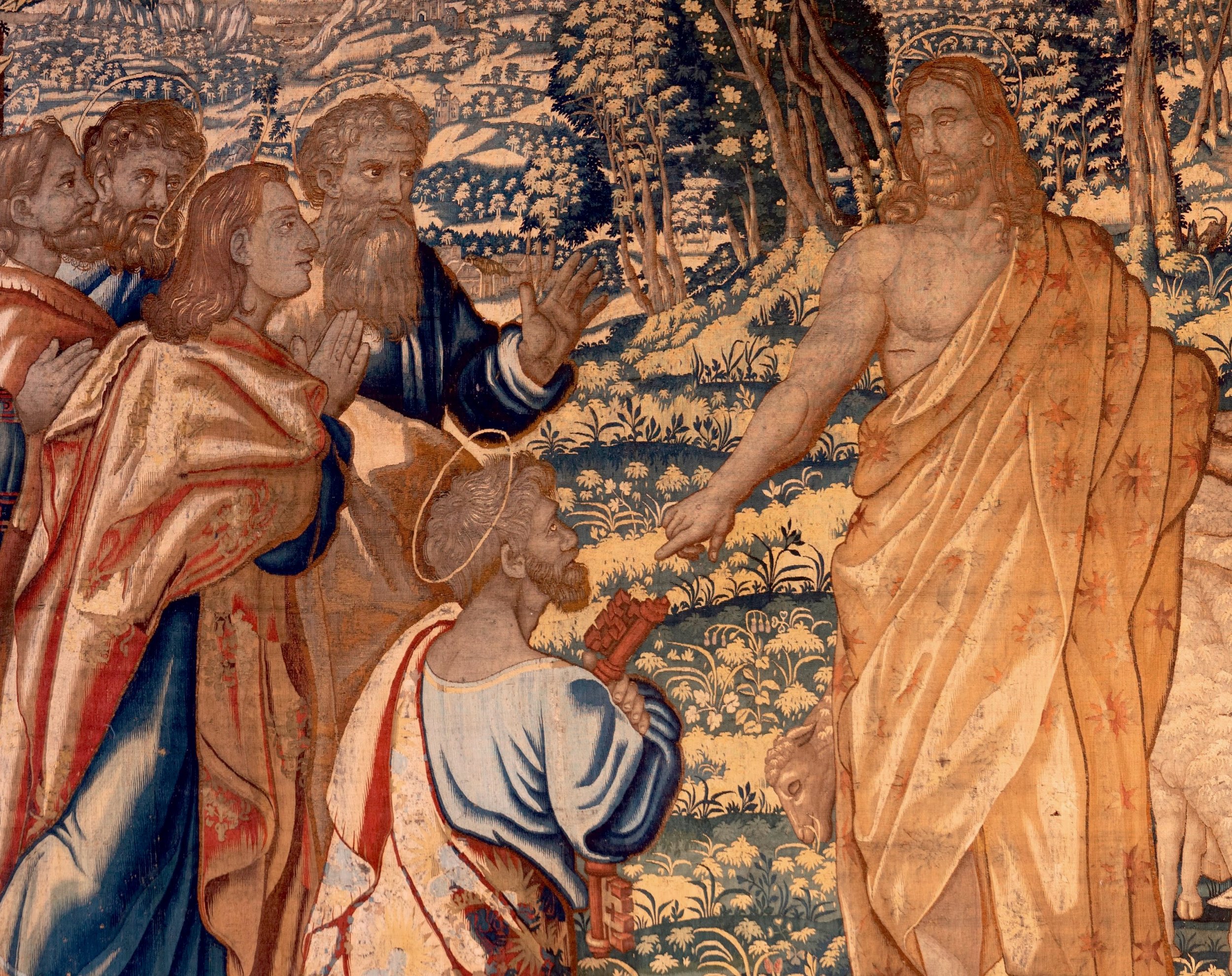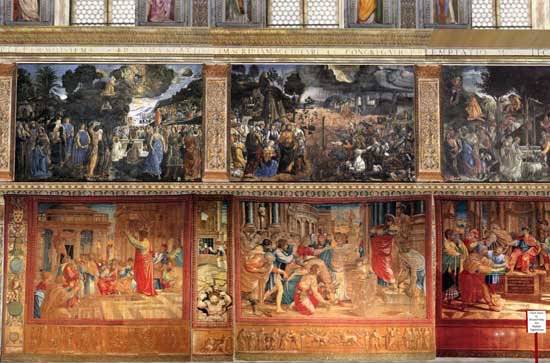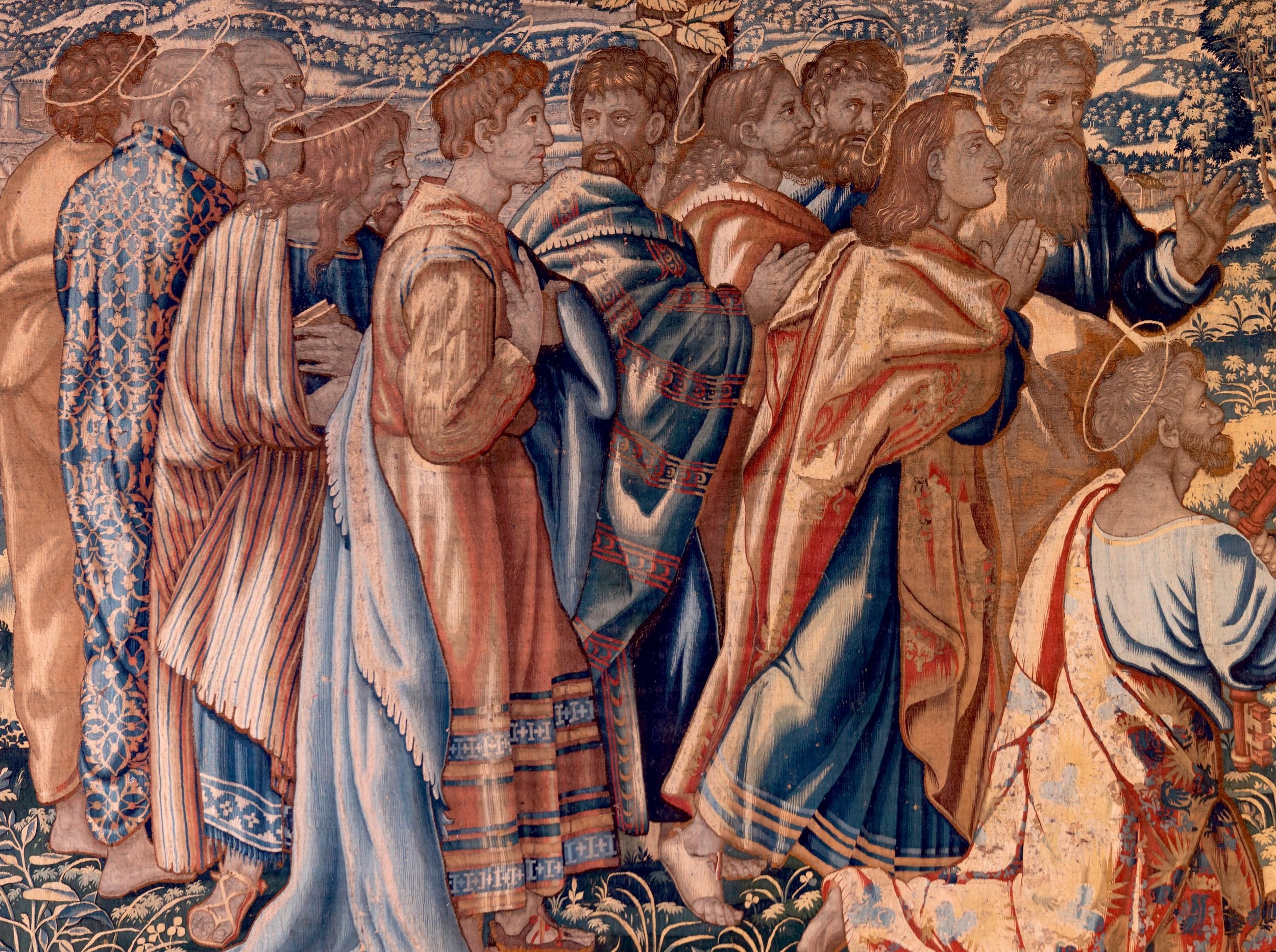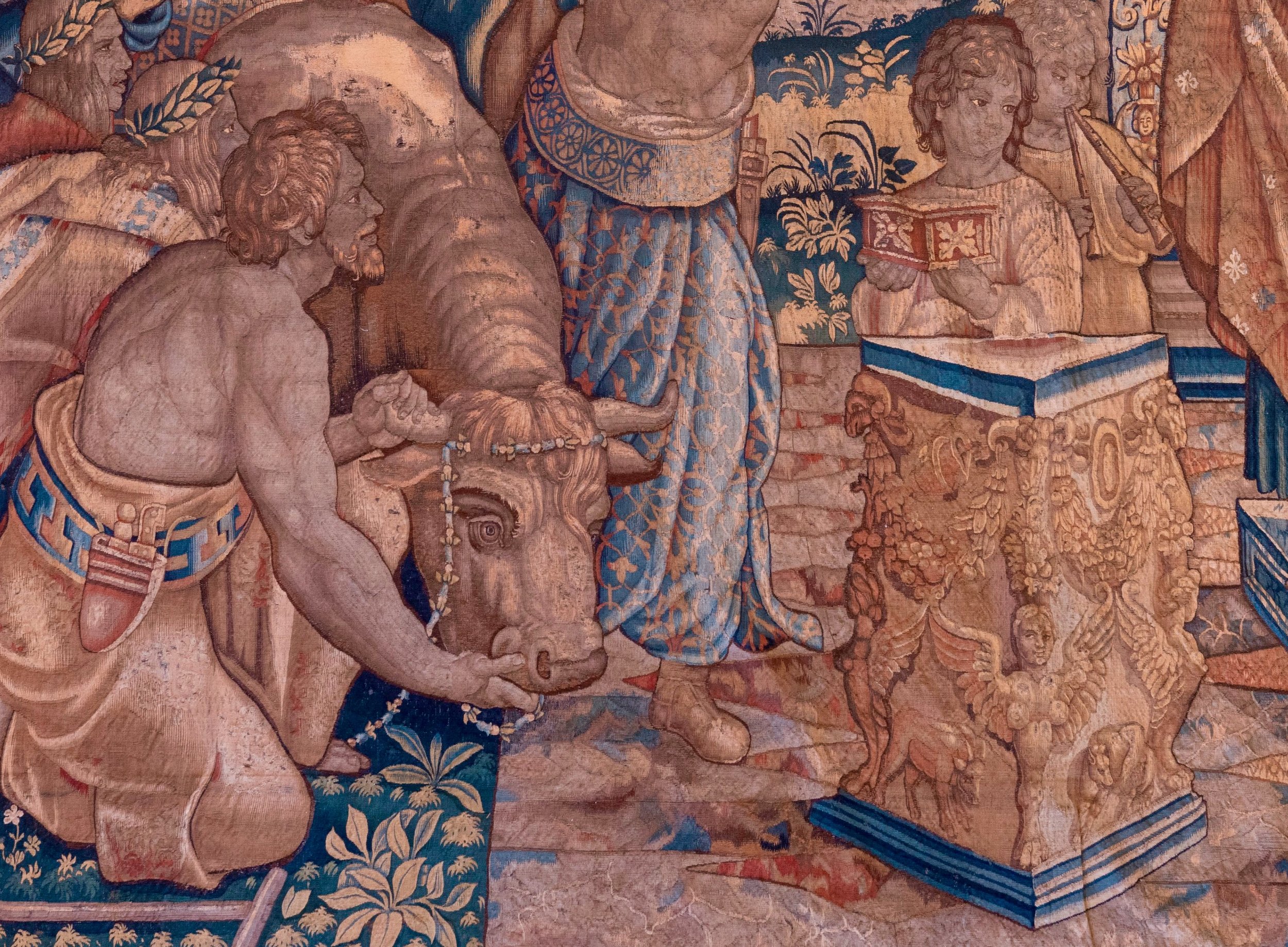Glencairn Museum News | Number 2, 2023
This tapestry in the Glencairn Museum collection, attributed to the workshop of Hans (Jan) Mattens after the artist known to us as Raphael (1483–1520), shows Peter kneeling with keys in his hand (see Matthew 16:15–19) while Christ stands before him.
Figure 1: Self-portrait of Raphael, aged approximately 23, 1504-1506. Pitti Palace, Uffizi Gallery, Florence, Italy. Public domain.
Although 2020 will be remembered for many reasons, mainly sad and unhappy ones, it nonetheless marked an important anniversary for art. It was the 500th year after the passing of Raffaello Sanzio da Urbino (1483–1520), better known to us as Raphael, who counts among the greatest figures of the Italian Renaissance, or even European art in general (Figure 1). Having developed as an artist around the court of Urbino, Raphael quickly gained attention for his luminous painted altarpieces, small devotional works and portraits. From 1508, Raphael spent twelve hectic years in Rome in the service of the papacy, where he burnished his reputation (and literally took his place in the Pantheon) with a series of artistic projects undertaken for Pope Julius II until his passing in 1513, and for his successor, Pope Leo X.
These works include the frescoes of the Vatican stanze, Pope Julius’s apartments, painted by Raphael and his workshop, comprising large-scale paintings of such importance as the School of Athens (Figure 2), which is long recognized as a supreme example of Western Renaissance art. In addition, Raphael was chosen one of three architects of Saint Peter’s following the death of his distant relative Donato Bramante in 1514, appointed the papal surveyor of antiquities, and worked on a variety of other significant artistic enterprises until his untimely passing at the age of only thirty-seven in April 1520.
One of the most important papal commissions Raphael received from Leo X, who was keen to use the arts to project his authority and status following his elevation, was for a set of designs for a series of tapestries relating episodes from the lives of Saints Paul and Peter. The intended location for the hangings were the walls of the Sistine Chapel, where the pieces would be installed on special occasions beneath the recently completed frescoed ceiling by Raphael’s rival, Michelangelo. Although up to sixteen weavings may have been envisaged, only ten were woven, including four episodes from the life of St. Peter, such as The Miraculous Draught of Fishes (Figure 3) and six relating to St. Paul, including The Conversion of Saul. (For a detailed description of the commission and tapestries in the set, see Tom Campbell ed., Tapestry in the Renaissance: Art & Magnificence, 2002.)
Figure 2: The School of Athens, Raphael, c. 1510-12. Vatican Museums, Italy. Public domain.
Figure 3: The Miraculous Draught of Fishes, Mattens workshop, about 1630. Indianapolis Museum of Art, Indianapolis, Indiana. Public domain.
As was typical for tapestry production, Raphael’s conception of the episodes had to be translated into large paintings executed by the artist and his studio assistants in body color (a glue distemper medium) on sheets of paper that were pasted together. These full-scale designs are known as “cartoons” and were followed carefully by the weavers at the loom, although because of the working process the finished tapestries are reversed from the designs. Created in Rome in the years 1515–1516, the completed cartoons (and separate cartoons for the innovative and elaborate tapestry borders) were sent to Brussels to be woven by expert Flemish weavers under the supervision of Pieter van Aelst (c. 1495–c. 1560), who led the greatest tapestry workshop of the day.
The manufacturing process was demanding and expensive, involving many hands to weave the tapestries on the looms and to incorporate lavish materials beyond already expensive wool, including strands of fiber wrapped with gold and silver. As a comparison, while Raphael was paid 1,000 ducats for his designs, the cost for weaving was around 16,000 ducats, a reflection of the commission’s prestige, expensive materials and labor investment inherent in tapestry production.
Figure 4: Raphael tapestries in the Sistine Chapel, 2011. Vatican Museums, Italy. Public domain.
As an extensive and complex project, it took time to finish the complete set, which was only ready in 1521, after Raphael’s passing. However, some weavings were finished earlier, with one recorded as complete in July 1517, while seven tapestries were shown in the Sistine Chapel on Christmas Day of 1519. The tapestries were immediately recognized as works of unsurpassed beauty and importance. They are still sometimes shown on special occasions, and the effect is glorious as it plays off the frescoes in the space, not only of Michelangelo’s ceiling and Last Judgment (which was painted later) but also those on the upper nave walls of the Life of Moses and the Life of Christ, completed in the preceding decades by painters from the previous generation—Sandro Botticelli, Pinturicchio, Davide Ghirlandaio, Cosimo Roselli and Raphael’s teacher, Perugino (Figure 4).
Because of the importance of the planned location of the tapestries and their relationship between the frescoed walls and ceiling, Raphael’s designs were meticulously planned and executed, with no areas of the cartoon left unrealized for the weavers to guess at the intended effect. His designs were revolutionary, and a challenge to the weavers to measure up to his conception of the medium of tapestry as a vehicle for monumental figurative narrative. All the compositions are marked by their great clarity in the placement of the figures and the use of gesture that allows the essential drama of all the scenes to be appreciated. When hung, the wide bottom borders would have raised the woven narrative scenes to the eye level of the seated audience in the chapel, which when combined with the sophisticated foreshortening and modeling of shadow (which responded to the likely placement of each hanging in a specific spot) would have created startling immediacy for the viewer.
Given the celebrated nature of the artist and the project, it is not surprising that subsequent weavings of the set were produced in the following decades by Brussels workshops, the first version of which is known to have been made with costly gold and silver wrapped threads for King Francis I of France in around 1533. The possibility of replicating the designs was enabled by the retention of most of the cartoons in Brussels, but even though Raphael’s works had been cut into long vertical strips for easier handling, storage and work on the loom, there is great likelihood that the originals were copied at full scale into a set of expendable working cartoons. (It is possible that the originals were intended to be returned to Rome, but this never occurred, due to the deaths of Raphael and Pope Leo X within a short period.) Other important patrons, including King Henry VIII of England, Emperor Charles V or King Phillip II of Spain and the Gonzaga family in Mantua obtained replica sets of the Acts of the Apostles tapestries from Brussels weavers in the period.
It is not until the early 1600s that seven of Raphael’s cartoons reappeared in Genoa, where they were acquired in 1623 by Prince Charles, later King Charles I of England, partly to support the output of the recently founded Mortlake tapestry manufactory, which was located in a village just outside London. Surviving use at Mortlake to create further series of the Acts of the Apostles for Charles I and members of his court, and the subsequent upheaval of the English Civil War and Charles’ execution in 1649, the Raphael cartoons were retained out of the thousands of masterpieces sold by the Commonwealth from the late king’s collections. No doubt this was thanks to Raphael’s fame and the appreciation of his designs as among the most significant works of Western art history. With the Restoration in 1660, the cartoons were returned to the monarchy, and eventually, the cartoons were permanently reassembled into complete panels and displayed at Hampton Court Palace, in a special gallery designed by Sir Christopher Wren. In 1865, Queen Victoria deposited the cartoons in the South Kensington Museum (later the Victoria & Albert Museum), where they remain on display. (For the story of the cartoons and to view ultra-high definition images, see here.)
The three weavings at Glencairn reflect the lasting high regard in which the Acts of the Apostles tapestries were held. Woven in wool and silk on wool warps and measuring 10 feet in height by 17 feet width for two, and 10 feet x 12 feet 7 inches for the other, one of the hangings shows a scene from the stories devoted to Peter, while the other two belong to the story of Paul.
Christ’s Charge to Peter (Figure 5) is the second scene in Peter’s set, after The Miraculous Draft of Fishes, and is a conflation of the Gospel of Matthew (16:15–19), where Christ tells Peter he will give him the keys to the Kingdom of Heaven, and the Gospel of John (21:14–17), when the risen Christ appears to his disciples and charges Peter to feed his sheep. In the tapestry, Peter kneels with keys in hand while Christ stands before him, pointing at Peter with his right hand, and gesturing to the sheep behind him with his left. The apostles are depicted as a group to the left, captivated by Christ’s presence and acting as witnesses to this designation; each is carefully individualized in their features and costumes to represent their diverse characters and emotional responses to the scene (Figure 6). A rowboat and Lake Tiberius are visible to the left, while a city and busy wooded landscape dominated by a large tree make up the background, in contrast to Raphael’s design, which is very sparse. Most importantly from Leo X’s perspective was that the narrative forms part of a tradition of emphasizing Peter’s preeminence amongst the apostles as the chosen vicar of Christ, thus reinforcing the authority of the papacy and its incumbent as Peter’s successor.
Figure 5: Tapestry based on Raphael cartoon. Attributed to the workshop of Hans (Jan) Mattens after Raphael, 1620s-1630s: Christ’s Charge to Peter, Glencairn Museum, Bryn Athyn, Pennsylvania, 10.TP.376. To view a zoomable version on Google Arts & Culture, click on the image.
Figure 6: Detail of the apostles, Christ’s Charge to Peter, Glencairn Museum, Bryn Athyn, Pennsylvania. To view a zoomable version on Google Arts & Culture, click on the image.
Glencairn’s other tapestries are from the “Paul” set, which in general emphasize the authority of the Church though his works as its minister. The second weaving depicts The Sacrifice at Lystra (Figure 7), related in the Acts of the Apostles (14:8–18). Saints Paul and Barnabas travel to Lystra (an ancient city located in what is now Turkey) on their first missionary journey, where Paul heals a lame man who had been unable to walk since birth. Having seen this miracle, a crowd believes the saints to be the pagan gods Mercury and Jupiter and bring animals and other rich offerings. The two saints stand at the right of the tapestry, Barnabas in a red robe behind Paul, who is turning away in disgust from the richly carved altar and the ox that has been brought for sacrifice (Figure 8). In the left foreground, a richly dressed older man lifts the blue garment of another, to reveal the healed leg of the cured man. The sacrifice is narrowly averted by the young man breaking forwards through the crowd with arm extended to stop the high priest bringing down his axe, and eventually Paul and Barnabas convince the Lystrians they are just mortals.
Figure 7: Tapestry based on Raphael cartoon. Attributed to the workshop of Hans (Jan) Mattens after Raphael, 1620s-1630s: The Sacrifice at Lystra, Glencairn Museum, Bryn Athyn, Pennsylvania, 10.TP.377. To view a zoomable version on Google Arts & Culture, click on the image.
Figure 8: Detail of the altar, The Sacrifice at Lystra, Glencairn Museum, Bryn Athyn, Pennsylvania. To view a zoomable version on Google Arts & Culture, click on the image.
The third tapestry of Paul Preaching at Athens (Figure 9) was Raphael’s last episode of the set, depicting the saint preaching in the Agora in the heart of the ancient Greek city, attempting to convert the adherents of pagan religion to Christianity (Act 17:22–23). Paul is shown at right on the platform with raised arms, surrounded by members of the Aeropagus (the council of archons) as he preaches to them. The audience reacts with varying expressions—of thought, skepticism and perhaps surprise—while a younger couple at the bottom left corner are converted by his words; the man with hands raised as if in prayer is Dionysius the Aeropagite, who became bishop of Athens and was canonized. Among the other figures, it is believed that the man wearing a red cap standing behind Paul is a portrait of Pope Leo X, or possibly of Tomasso Inghirammi, a friend of Raphael who died around the time the cartoon was created (Figure 10). The background in the Glencairn tapestry is very different to Raphael’s conception, which shows the episode taking place in the city. His composition (Figure 11), which was reversed in the process of weaving, places buildings in the background, including one closely resembling the Tempietto, a High Renaissance chapel designed by his cousin Bramante. In addition, a figure of the pagan god of war Ares/ Mars (“Aeropagus” is the hill of Ares), with its back turned to the viewer, symbolizes the ousting of ancient beliefs by Christianity.
Figure 9: Tapestry based on Raphael cartoon. Attributed to the workshop of Hans (Jan) Mattens after Raphael, 1620s-1630s: Paul Preaching at Athens, Glencairn Museum, Bryn Athyn, Pennsylvania, 10.TP.383. To view a zoomable version on Google Arts & Culture, click on the image.
Figure 10: Detail of Pope Leo X, or possibly Tomasso Inghirammi, Paul Preaching at Athens, Glencairn Museum, Bryn Athyn, Pennsylvania. To view a zoomable version on Google Arts & Culture, click on the image.
Figure 11: Tapestry cartoon of Paul Preaching at Athens, Raffaelo Sanzio da Urbino, about 1515–1516. Victoria and Albert Museum, London, England.
Although such changes adjust the intended meaning of the tapestries, these may be explained by changing expectations and prevailing fashions of the time in which the Glencairn hangings were executed. It is straightforward to see the differences between the Vatican weavings and subsequent sets woven in the 1500s to the Bryn Athyn ones. While the Glencairn weavings follow the designs for figures, gestures, and draperies quite closely (even including in Christ’s Charge to Peter the starry robe worn by the risen Christ in the Vatican weaving, an adaptation by the Flemish weavers from Raphael’s cartoon, where Christ wears white) the tapestries feature major differences in the pattern of garments, and of busy hilly landscape backgrounds dotted with trees. Further, the Glencairn panels are more broadly woven, do not include metallic threads and have a narrower pictorial field than the original designs. One should assume that these hangings had borders, but they have been removed, along with the selvedges that would have included a town mark and weaver’s mark definitively identifying its maker. The outcome of these adaptations does not diminish the beauty or impact of the Glencairn Acts of the Apostles, yet it does underline a less strict approach to the cartoons than one would expect of the decades immediately following the first weaving.
In fact, some re-weavings of the series made in Brussels in the 1620–1630s offer a closer comparison to the Glencairn hangings. Evidently, good quality copies of the cartoons remained in circulation in Brussels in the early 1600s, and the fame and quality of the designs surely maintained the popularity of the series. One important, documented set of the Acts of the Apostles can be found in the Museo Pontificio della Santa Casa in Loreto (the museum is part of the shrine dedicated to the miraculous holy house of the Virgin Mary inside the basilica). This set bears the mark of a Brussels weaver, Hans (or Jan) Mattens (active 1613, d. 1633 or 1634) and was woven in 1620-1624 for Giovanni Battista di Niccolò Pallavicino, a wealthy Genoese nobleman who presented the set to the Santa Casa shrine in 1667 (Figure 12). While the coloration and details of the set and backgrounds are finer than the Glencairn weavings (the Loreto set also included expensive gold and silver wrapped threads) the treatment of figures, faces and drapery patterns is comparable, a treatment one can also observe in a single Mattens workshop tapestry of the Miraculous Draft of Fishes in the collection of Newfields / Indianapolis Museum of Art (see Figure 3).
Figure 12: Acts of the Apostles tapestries in the Museo Pontificio della Santa Casa, Loreto, Italy. Woven by Hans Mattens in 1620–1624. Photograph: Sailko. Creative Commons Attribution 3.0 Unported.
As the hilly, tree-filled background seen in the Glencairn works was a popular characteristic of Flemish weavings of the later 1500s and early 1600s, one wonders if the tapestries were designed to be slightly more decorative products made for ready sale by the Mattens workshop, or if there were a commissioner behind these pieces, they were offered the choice to place the figural groups within more generic backgrounds as a way to save money on what would still have been a substantial purchase.
The Glencairn Acts of the Apostles tapestries were an unquestionably grand addition to the collections in Bryn Athyn, and were purchased by Raymond Pitcairn in 1931 through an obscure series of agents supposedly working on behalf of a Comte de Spinetti of Brussels, who—it was said—in turn had them from a relative, “Cardinal Caspari” (presumably, one of the Cardinals Gasparri of the early 1900s). Pitcairn had seen them on display at St. Thomas’ Church in New York, where they had been placed for sale, or possible donation to the church, along with a fourth tapestry from the set representing The Stoning of Stephen, which he did not buy and now sadly cannot be traced. As was typical of Pitcairn’s generosity with his collections during the period of construction of Glencairn (and long after), his tapestries were lent to the Philadelphia Museum of Art in 1934.
But we might wonder what Raymond Pitcairn found most interesting about them. In a talk given at Glencairn about the tapestries in 2010, Jonathan Kline suggested that Pitcairn purchased the pieces out of his interest in tapestry as potential decoration for Bryn Athyn Cathedral, in effect as a kind of artistic model in the same vein as his collections of medieval sculpture and stained glass, or if not that, then as sumptuous décor for his new family home. Photographs and documents in the archives at Glencairn Museum show that The Sacrifice at Lystra and Christ’s Charge to Peter hung on the upper walls of the Great Hall for an extended time after the completion of the house. It is not known exactly when they were removed and placed in collections storage, but this may have been motivated by their condition when Glencairn became a museum in the early 1980s. Nevertheless, these fascinating tapestries are of comparable significance to the rest of the superb collections at Glencairn, and one hopes that they will be on view more often in the Great Hall in the future.
Jack Hinton
Henry P. McIlhenny Curator of European Decorative Arts and Sculpture
Philadelphia Museum of Art
Would you like to receive a notification about new issues of Glencairn Museum News in your email inbox (12 times per year)? If so, click here. A complete archive of past issues of Glencairn Museum News is available online here.













